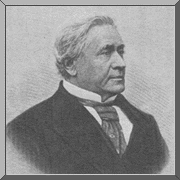 Joseph
Henry, physicist and scientific administrator, was born on
December 17, 1797. Although he was largely self-educated, Henry
studied at the Albany, NY, Academy from 1819 to 1822. Henry, began
teaching at the Academy in Albany in 1826 where he remained until
1832 when he accepted a position at the College of New Jersey (now
Princeton University).
Joseph
Henry, physicist and scientific administrator, was born on
December 17, 1797. Although he was largely self-educated, Henry
studied at the Albany, NY, Academy from 1819 to 1822. Henry, began
teaching at the Academy in Albany in 1826 where he remained until
1832 when he accepted a position at the College of New Jersey (now
Princeton University).
His experimental work in chemistry, electricity, and magnetism reflected only a small portion of his broad scientific interest. Henry is known primarily for his discovery of electromagnetic induction, and self-induction. He is also credited with the invention of the electric motor.
In 1846, Henry became the first secretary of the newly organized Smithsonian Institution, where he established a continuing tradition of research. Under his leadership, weather reporting stations were connected by telegraph in the United States. These weather reporting stations were organized and maintained by the U.S. Army signal corps. This organization would become, in 1891, the U.S. Weather Bureau (Service). Henry also directed the resources of the Smithsonian Institution to encourage research in the areas of astronomy, botany and Native American anthropology.
In the spring of 1863 Henry became one of the founding members of the National Academy of Science, and served as Academy president beginning in 1867. He served as both the National Academy of Science president and secretary of the Smithsonian Institution until his death in 1878. In 1893 his name was given to the standard electrical unit of inductive resistance, the henry.
Designed by: Barry Goldsmith
Asimov, I. (1964). Asimov's Biographical Encyclopedia of Science and Technology: The Living Stories of More than 1000 Great Scientists from the Age of Greece to the Space Age Chronologically Arranged. Garden City, NY: Doubleday.
Debus, A.G. (1968). World Who's Who in Science: A Biographical Dictionary of Notable Scientists from Antiquity to the Present. Chicago: Marquis.
McGraw-Hill (1966). McGraw-Hill Modern Men of Science. New York: McGraw Hill.
Smithsonian Institution (1997) The Joseph Henry Papers